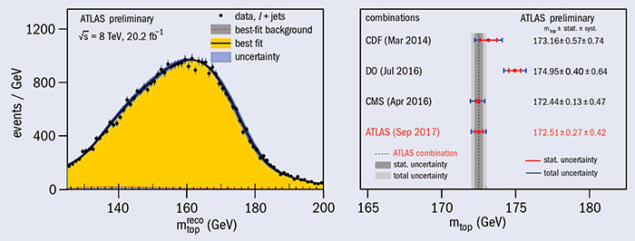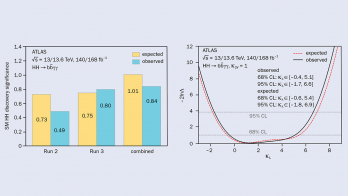
The top quark is copiously produced at the LHC, allowing for very precise measurements of its properties. The mass of the top quark, mtop, plays a special role in the Standard Model (SM) of particle physics. It is a key part of the mechanism of electroweak symmetry breaking and one of the parameters governing the stability of the universe in the SM.
Following years of meticulous work, ATLAS presented a new measurement of mtop at the 10th International Workshop on Top Quark Physics held in Braga, Portugal, in late September. The measurement was performed using around 100,000 proton–proton collision events at an energy of 8 TeV, each containing a top-quark pair reconstructed in the single-lepton final state. In this channel, each top quark immediately decays to a W boson and a bottom quark, and one W boson decays to an electron or muon and a neutrino, while the second W boson decays to two light quarks.
A simultaneous measurement of mtop together with a global jet-energy scale factor and a relative bottom-to-light jet-energy scale factor was performed. The inclusion of these scale factors strongly reduces systematic uncertainties. The precision of the measurement is further improved by differentiating between correctly reconstructed top-quark events and events where the final-state objects are incorrectly assigned to the two top quarks. While only retaining 40% of the events, the total uncertainty is improved by 19%, leading to a top-quark mass of 172.08±0.91 GeV.
The power of this measurement, which is the second most precise individual top-quark mass measurement made by ATLAS to date, is revealed when combined with previous ATLAS measurements in the single-lepton channel at 7 TeV and the dilepton channel at 8 TeV. This combination relies on a careful evaluation of the correlation between measurements for all sources of systematic uncertainty. In both channels at 8 TeV, the analysis optimisation trades reduced systematic against increased statistical uncertainty, thereby reducing the correlation among the measurements. The combined result thus has a 41% smaller uncertainty than the single most precise measurement. The current combined value is 172.51±0.50 GeV with a relative precision of 0.29%, which is mainly limited by the calibration of the jet-energy scales and is similar to that of the leading single-experiment combined measurements.
The current precision on mtop represents a significant achievement that demonstrates the precise understanding of all the relevant aspects of the ATLAS detector. The measurement will allow further and deeper tests of the consistency of the SM.








